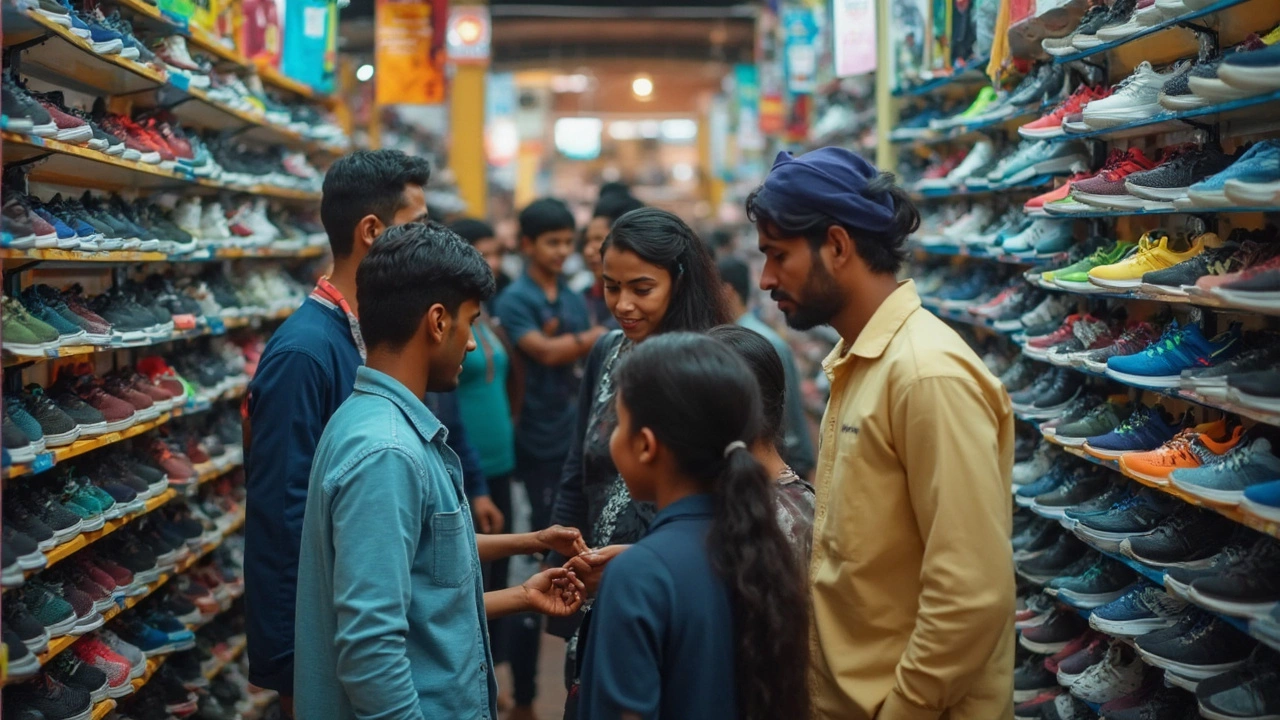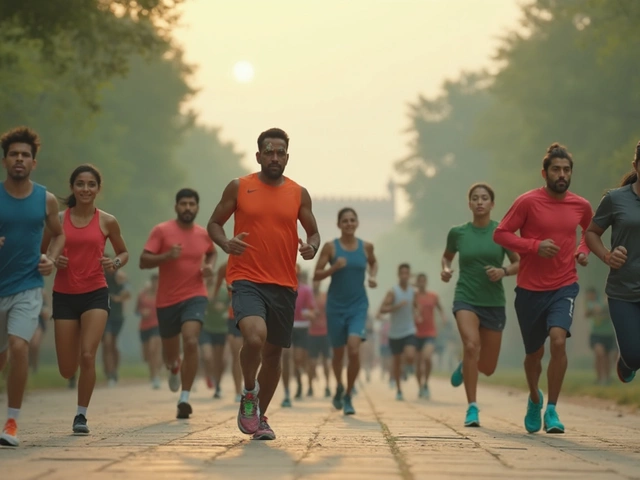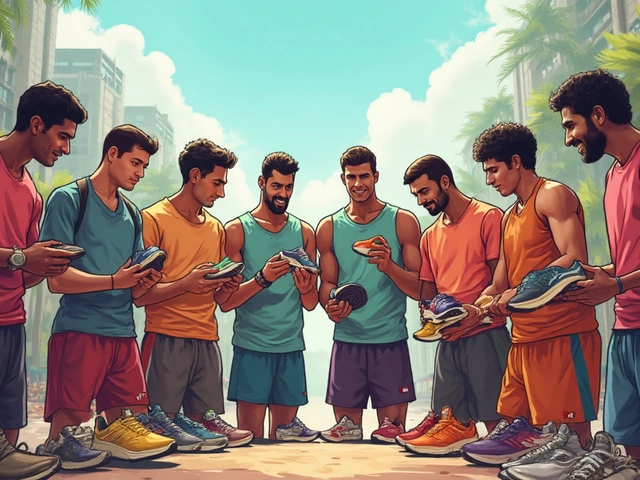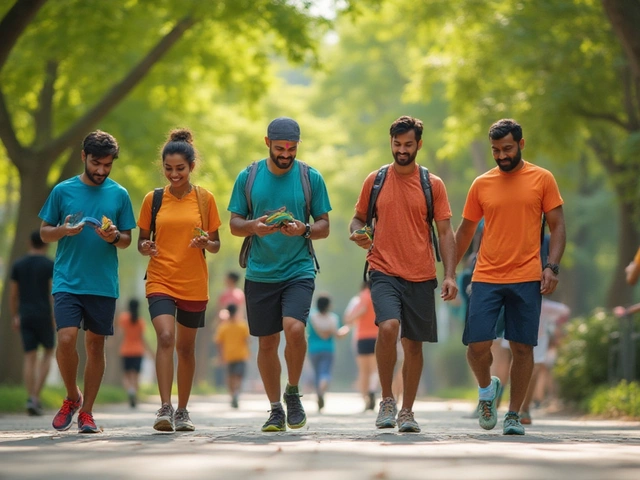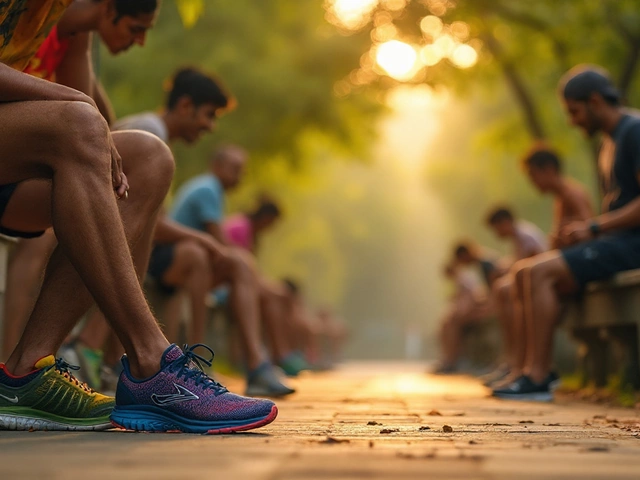Stickers on running shoes can leave you with more questions than answers. You walk in, spot something snazzy, flip the tag, and—whoa—why does it feel like buying a plane ticket? Here’s the blunt truth: a good running shoe usually costs somewhere between $100 and $160 if you’re looking at well-known brands. Can you find shoes for $50? Sure, but they're rarely worth it if you plan on running more than to the mailbox and back.
Seriously, shoe prices jump around for more reasons than you might think. Some of it is about cushioning technology, some of it’s flashy extras, and—yup—we all pay a bit for that cool logo on the side. But do you need to go for the most expensive pair in the store? Not always. And let’s be real, sometimes mid-range shoes get the job done for both beginners and regular runners. My own sneakers usually sit right around $120, and I pound out miles with Bruno next to me and Whiskers trying to bite the laces when I get home.
- The Real Price Range of Good Running Shoes
- What Are You Paying For?
- Is Expensive Always Better?
- Where to Save Money (Without Sacrificing Quality)
- Weird Industry Facts and Sneaker Myths
- Tips Before You Buy
The Real Price Range of Good Running Shoes
Walk into any running store and you’ll see prices all over the place. The honest answer? For a running shoe that actually performs and lasts, $100 to $160 is the most common window. Want something built for marathons or the latest tech? You’ll see pairs climbing up toward $200 and more. On the other hand, some budget brands throw out options under $70, but those usually cut corners somewhere—think cheaper materials, clunky design, or zero support past a few months of real running.
The big brands—Nike, Adidas, Brooks, Asics, Hoka—all target that $120 to $160 sweet spot for their classic daily trainers. Specialized models (like super-light racers or trail shoes with rock plates) start at $150 and can swing past $250. Below $100, it’s a bit of a gamble for serious runners, but good deals pop up, especially on older versions when a new model comes out.
To give you a quick snapshot, here’s the typical breakdown you’ll spot in stores or online:
| Price Range (USD) | What You Get | How Long They Last |
|---|---|---|
| $50 - $90 | Basic, older tech, minimal support or cushioning | 200-300 miles |
| $100 - $160 | Modern tech, good support, durable materials, most brand options | 300-500 miles |
| $170 - $250+ | Race-day or specialty models, advanced foams, carbon plates | 200-400 miles (racers wear down quicker) |
A lot of people get tripped up thinking they need to pay top dollar. Truth is, unless you’re chasing a podium finish or geeking out over every gram, daily trainers sitting in the $120 to $140 range work for most folks. Check out last year’s models—they often drop $30-$40 when the new ones hit and you’re still getting the same essential features.
One tip: retailers run sales right after major races (like the NYC Marathon), during back-to-school, and in January when New Year’s resolution crowd floods the gym. Stack those sales with store loyalty rewards and you could snag a great pair for way less than sticker price. If you’re buying online, double-check return policies so you’re not stuck with a pair that doesn’t fit once you take them for a spin.
What Are You Paying For?
So, why do some running shoes scream $180 and others chill around $80? There’s a bunch of stuff packed into that price, not just colorful mesh and swooshy logos. The main things you’re paying for break down into real tech, materials, brand hype, and how the shoe fits with your running needs.
- Materials: Quality uppers (like engineered mesh) and midsoles made with fancy foams (like Adidas’ Boost or Nike’s ZoomX) boost the shoe’s price. Better foam means more bounce and longer lifespan.
- Cushioning Tech: Shoes pack in features like gel pods, air pockets, or carbon plates. These aren’t just for show—they help protect your joints, control energy return, and make each stride smoother. For example, that carbon-fiber plate trend? It can push shoes over $200, but it does help with speed for racers.
- Durability: Shoes that actually last 300–500 miles usually have solid outsole rubber and reinforced stitching. Supertough outsoles, like those on trail runners, drive up the price too.
- Brand and Style: Let’s be honest, we pay extra for the logo. Limited edition drops or designer collabs? You’re mostly paying for hype. The average runner doesn’t need these—unless showing off on Instagram is your goal.
Here’s a quick look at what you’re actually paying for in most running shoe purchases:
| Feature | How It Affects Price |
|---|---|
| Advanced Foam (e.g. ZoomX, Boost) | Adds $30–$50 |
| Carbon Plate | Adds $50–$100 |
| Specialized Mesh/Rubber | Adds $10–$30 |
| Big Brand Name | Adds $20–$40 |
| Limited Edition/Collab | Adds $30+ (sometimes way more) |
The wild thing? Not everyone needs the bells and whistles. My advice: figure out what you’ll actually use. If you only jog a few times a week, you probably don’t need a carbon plate. But if heel pain has you limping like Bruno after a long fetch session, splurge a bit on better cushioning—your joints will thank you later.
Is Expensive Always Better?
The big question: does dropping more cash on a pair of running shoes mean you’ll get something better for your feet? Not always. Brands like Nike, Adidas, or Hoka can sell shoes over $200, especially the latest "carbon plate" models. These high-tech kicks are built for super serious runners or racers going for a personal best. But those top-shelf models often make more sense for elite runners than everyday folks.
Let’s break it down with actual numbers. A 2023 survey by RunRepeat found that most runners rated their $120 shoes just as comfortable as shoes costing $180+. Another stat: the popular Brooks Ghost line (a favorite with everyday runners) regularly gets top ratings and sits in the $130-$150 range. Stuff like fit, the shape of your foot, and wearing the right shoe for your running style matter way more than price tags.
What do those extra dollars buy you? Here’s what tends to drive up costs:
- Advanced tech like carbon fiber plates or special foams for speed
- Premium upper materials that hug your foot but breathe well
- Brand hype and limited releases—less about running, more about fashion
- More research behind shoe design (sometimes, but not always)
But plenty of everyday shoes without wild features still deliver that comfy, shock-absorbing feel. For example, New Balance’s Fresh Foam 880 is a workhorse for about $140, while Asics’ Gel-Cumulus keeps runners happy at a similar price.
Take a look at a quick price comparison of popular models (as of late 2024):
| Brand & Model | Approx. Price (USD) | Tech Features |
|---|---|---|
| Nike Alphafly 3 | $285 | Carbon plate, ZoomX foam |
| Brooks Ghost 16 | $140 | DNA Loft cushioning |
| Asics Gel-Cumulus 26 | $140 | Gel cushioning, engineered mesh |
| Hoka Clifton 10 | $145 | Meta-Rocker, EVA foam |
| Adidas Adizero Adios Pro 3 | $250 | Carbon EnergyRods, Lightstrike foam |
If you’re not breaking world records or running marathons every other weekend, there’s no real need to spend $200+. Most people find their perfect fit and comfort zone way below that top tier. Try on shoes, look for comfort, and remember: buying higher-priced doesn’t always equal happier running.
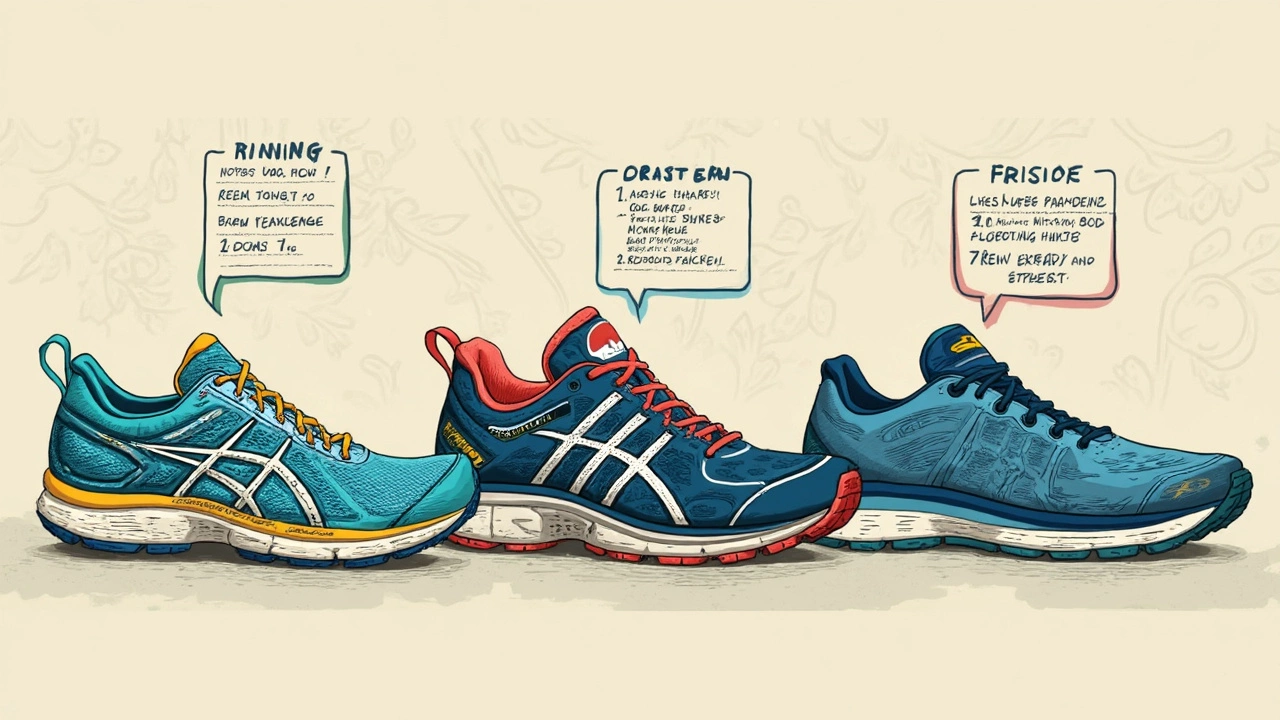
Where to Save Money (Without Sacrificing Quality)
If you want solid running shoes but hate the idea of spending an arm and a leg, you’ve got options. You just need to know a few tricks and watch out for marketing nonsense. Most big brands like Nike, Brooks, Asics, and New Balance drop slightly older models once per year. Guess what? Last year’s shoe can still be awesome for your daily runs, but comes with a price tag that's 20–40% lower than the all-new version.
Check this out—according to a 2024 pricing report by Sports Industry Analysts, the average price drop for top running shoe models once the new version launches is about 32%. So that $150 pair from this year? You might get it for $102 by waiting just a bit. Here’s a snapshot from real deals I’ve seen:
| Model Year | Original Price | Discount After New Release |
|---|---|---|
| 2023 Nike Pegasus | $130 | $90 |
| 2023 Brooks Ghost | $140 | $99 |
| 2022 Asics Gel Nimbus | $160 | $115 |
Another solid tip: Hit up major holiday sales. Black Friday, end-of-season clearouts, and even back-to-school promos can knock legit dollars off high-quality shoes. I grabbed my last pair for under $100 right after New Year’s—no difference from the newer model except the color.
Shopping at specialty running stores? Always ask if they have last-gen or clearance stock in the back. Most stores keep them since not everyone wants the hottest release. Also, don’t sleep on online outlets like Running Warehouse or the brand’s original website clearance section—sometimes you’ll find fan favorites or oddball colorways for deep discounts with full warranty.
If you don’t need to be first on the block with neon green soles and the latest design tweaks, you can save real money while getting reliable comfort, durability, and performance. Just make sure you’re still buying from legit shops, not counterfeit sites or sketchy marketplaces. And if you’re willing to skip the bells and whistles, $80–120 can usually score you everything you need for road runs, training, or even racing.
Weird Industry Facts and Sneaker Myths
Let’s dig into some of the wild backstage stuff from the running shoe world. Most people think the main reason a pair of running shoes costs so much is materials. Reality? The average sneaker retails for about five times what it actually costs to make. That covers marketing campaigns, athlete endorsements, and the design team’s endless trial-and-error with fancy foam. The material itself—mesh, rubber, and cushion—often makes up less than 25% of the total price tag.
Here’s another shocker: Most modern running shoes don’t change much from year to year. They get new colorways, maybe a slight tweak in the midsole, but all the buzz about “revolutionary upgrades” is mainly hype to get us to buy more. Limited edition drops for certain models? They’re often just a standard shoe in a rare color with a steeper price.
Now, about those common myths:
- More cushioning doesn’t always mean better. Too much can even mess up your stride or hurt your feet after a while.
- Shoes don’t “break in” after hundreds of miles. Most good pairs feel right within a short walk around the block, and if they don’t—you’ve probably picked the wrong size or fit.
- Price doesn’t guarantee quality. Some big-name brands mark up basic models, assuming shoppers think expensive equals better. Test for fit and support instead of just trusting the tag.
- Rotating multiple shoes isn’t just marketing. Runners who switch pairs between runs actually help shoes last longer and reduce injury risk—just don’t buy into the hype that every shoe in your closet has to be top of the line.
Kind of makes you rethink that next trip to the shoe store, right?
Tips Before You Buy
Grabbing the right pair of running shoes feels confusing because every store claims theirs are the best. Here’s how to dodge regret and score a great fit for your feet and your wallet.
- Try Before You Buy: Feet swell by the end of the day and after running, so shop in the afternoon or evening. Bring the socks you actually run in. Don’t just stand or walk—jog around the store if they let you.
- Get Measured Yearly: Up to 60% of people wear the wrong size shoes. Your foot size can change with age, weight, and even the weather. Many pro shops will measure your feet for free.
- Test Return Policies: Some stores like Road Runner Sports or big brands offer a 30 to 90-day run-trial guarantee. If the shoes hurt after a week or two, send them back for a swap or refund.
- Compare Online and In-Store Prices: Don't pay more than you have to—apps like Honey or Google Shopping track big sales. Sometimes, the in-store price drops after an online sale, especially at the end of a shoe model season.
- Don’t Fall for the Flashiest Model: New releases cost more, but last year’s models usually have the same tech for less cash. Sneaker nerds know some of the most highly rated shoes are hidden in clearance bins.
- Understand Your Gait: Pronation, supination, and neutral gait sound complicated, but a quick video at most local running stores will sort you out. This helps you avoid repeat blisters, knee pain, or weird wear patterns.
Curious how shoppers actually buy? Check this:
| Factor Shoppers Consider | Percentage (%) |
|---|---|
| Comfort / Fit | 85 |
| Price | 70 |
| Brand Reputation | 55 |
| Style / Design | 38 |
| Return Policy | 22 |
One last thing—don’t toss your old shoes the minute you buy new ones. Rotate them. Most runners get 300–500 miles from a good pair, but rotating helps shoes dry out and last longer. Just keep an eye on worn down treads; if the grip is bald, it’s time to say goodbye. Your knees and feet will thank you.
